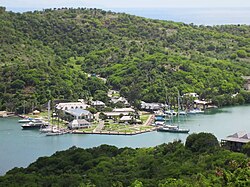Parish of Saint Paul[1] | |
|---|---|
(from top: left to right) Shirley Heights, St. Paul's Church, Tyrells Roman Catholic Church, Nelson's Dockyard, | |
![Location of Parish of Saint Paul[1]](http://upload.wikimedia.org/wikipedia/commons/thumb/1/11/Saint_Paul_in_Antigua_and_Barbuda_%28cropped%29.svg/250px-Saint_Paul_in_Antigua_and_Barbuda_%28cropped%29.svg.png) | |
| Country | Antigua and Barbuda |
| Established | January 11, 1692 (old style) January 21, 1692 (new style) |
| Capital | Falmouth |
| Largest city | Liberta |
| Government | |
| • MPs | Paul Chet Greene, Sherfield Bowen, Jamale Pringle |
| Population (2018[2]) | |
| • Total | 9,004 |
| Ethnicities | |
| • African/Black | 91.24% |
| Time zone | UTC-4 (AST) |
Saint Paul, officially the Parish of Saint Paul, is a parish of Antigua and Barbuda on the island of Antigua. It had an estimated population of 9,004 in 2018.[3] The parish capital, and the location of the parish church, is Falmouth. The main economic and tourism hub of the parish is English Harbour.
Saint Paul borders Saint Peter and Saint John to the north, Saint Mary to the west, and Saint Philip to the east. Saint Paul is dominated by farmland in the north, with various creeks and Potworks Dam marking its northern border, and low-lying hills to the south, defining its western border with Saint Mary. The largest city fully within the parish is Liberta, the third largest city in the country.[4] Saint Paul was permanently established with the other four original parishes in 1692.[5]
Saint Paul is mostly dominated by tourism and agriculture, with most settlement in the parish being based around Tyrells Main Road and Matthews Road.[citation needed] The northeastern portion of the parish is very sparsely populated with the only settlement in this region being Bethesda. The eastern coast of the parish along Willoughby Bay also has a very low population, with little exception. Saint Paul has very few islands, but many peninsulas.
Saint Paul is a major tourism hub on the island. Saint Paul is different from the rest of Antigua as it is not a major hub for beach tourism, due to its very few "clear water" beaches. Most tourism activity centres around yachting, restaurants, and hotels. Saint Paul is home to many amenities and facilities that would only be seen in St. John's City, due to its tourism and yachting importance. Saint Paul is home to English Harbour and Falmouth Harbour, some of the most important harbours in the country. Saint Paul is home to many marinas, one of the only ports of entry in the country, and a station of the Antigua and Barbuda Coast Guard.
Saint Paul was created in August 1681, when Antigua was divided into five parishes.[5] Saint Paul and the four other parishes were permanently established in July 1692, and confirmed in January 1693.[5] The primary objective of the establishment of parishes was providing for the parish church. A large portion of the parish's lands were used for agricultural purposes. Numerous historical relics from the parish can still be seen today, including the Savannah[6] and Guinea Bush plantations.[7]
- ^ http://laws.gov.ag/wp-content/uploads/2018/08/cap-304.pdf [bare URL PDF]
- ^ "Antigua and Barbuda 2018 Labour Force Survey Report" (PDF). statistics.gov.ag. Statistics Division, Ministry of Finance and Corporate Governance, Antigua and Barbuda. October 2020.
- ^ "Antigua and Barbuda 2018 Labour Force Survey Report" (PDF). statistics.gov.ag. Statistics Division, Ministry of Finance and Corporate Governance, Antigua and Barbuda. October 2020.
- ^ "Biggest Cities In Antigua and Barbuda". WorldAtlas. 2019-09-16. Retrieved 2024-08-16.
- ^ a b c The Laws of the Island of Antigua: Consisting of the Acts of the Leeward Islands, Commencing 8th November 1690, Ending 21st April 1798; and the Acts of Antigua, Commencing 10th April 1668, Ending 7th May 1804. Strand, London: Samuel Bagster. 1805.
- ^ "Savannah – Antigua Sugar Mills". Retrieved 2023-10-15.
- ^ "Guinea Bush/Monk's Hill – Antigua Sugar Mills". Retrieved 2023-10-15.



